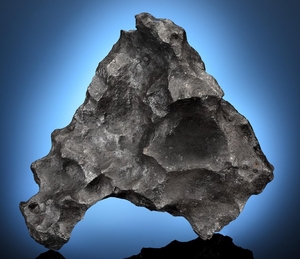Deep Impact: Martian, Lunar and other Rare Meteorites
An outthrust from the mass provides an arch and numerous ridges, furrows and flanges abound. A large crest is offset by a socket that formed over tens of thousands of years when Odessa was exposed to the Texas elements. A deep gun-metal patina with pewter highlights and earthen accents cover this distinguished specimen.
291 x 313 x 129 mm. (11½ x 12⅓ x 5 in.) and 22.48 kg. (49½ lbs)
The archetype of a superior iron meteorite from one of the most historic American iron meteorite showers. Originating from an asteroid located between Mars and Jupiter, the Odessa mass was blasted off its parent and deflected into an Earth-crossing orbit. About 75,000 years ago, the Odessa meteorite entered the Earth’s atmosphere as a large fireball and broke up in flight, creating several craters in what is now a working Texas oilfield. The meteorite offered here originates from the most famous American impact event after Meteor Crater in Arizona (see lot 18). Odessa’s impact occurred at nearly the same time as the Mount Toba eruption, the largest supervolcano eruption of the last 2.5 million years, which some scientists believe contributed — along with disease — to the near total extinction of human species.
This meteorite is composed primarily of iron and nickel. The terrestrial sculpting now seen is as a result of it having been exposed to the elements as the seasons turned over thousands of years. Only about 4% of all meteorite falls are of the iron-nickel variety, and the legacy of this choice example is further enhanced by its participation in the famed Odessa impact event.
Christie's would like to thank Dr. Alan E. Rubin at the Institute of Geophysics and Planetary Physics, University of California, Los Angeles for his assistance in preparing this catalog note.
View it on
Estimate
Time
Auction House
An outthrust from the mass provides an arch and numerous ridges, furrows and flanges abound. A large crest is offset by a socket that formed over tens of thousands of years when Odessa was exposed to the Texas elements. A deep gun-metal patina with pewter highlights and earthen accents cover this distinguished specimen.
291 x 313 x 129 mm. (11½ x 12⅓ x 5 in.) and 22.48 kg. (49½ lbs)
The archetype of a superior iron meteorite from one of the most historic American iron meteorite showers. Originating from an asteroid located between Mars and Jupiter, the Odessa mass was blasted off its parent and deflected into an Earth-crossing orbit. About 75,000 years ago, the Odessa meteorite entered the Earth’s atmosphere as a large fireball and broke up in flight, creating several craters in what is now a working Texas oilfield. The meteorite offered here originates from the most famous American impact event after Meteor Crater in Arizona (see lot 18). Odessa’s impact occurred at nearly the same time as the Mount Toba eruption, the largest supervolcano eruption of the last 2.5 million years, which some scientists believe contributed — along with disease — to the near total extinction of human species.
This meteorite is composed primarily of iron and nickel. The terrestrial sculpting now seen is as a result of it having been exposed to the elements as the seasons turned over thousands of years. Only about 4% of all meteorite falls are of the iron-nickel variety, and the legacy of this choice example is further enhanced by its participation in the famed Odessa impact event.
Christie's would like to thank Dr. Alan E. Rubin at the Institute of Geophysics and Planetary Physics, University of California, Los Angeles for his assistance in preparing this catalog note.



